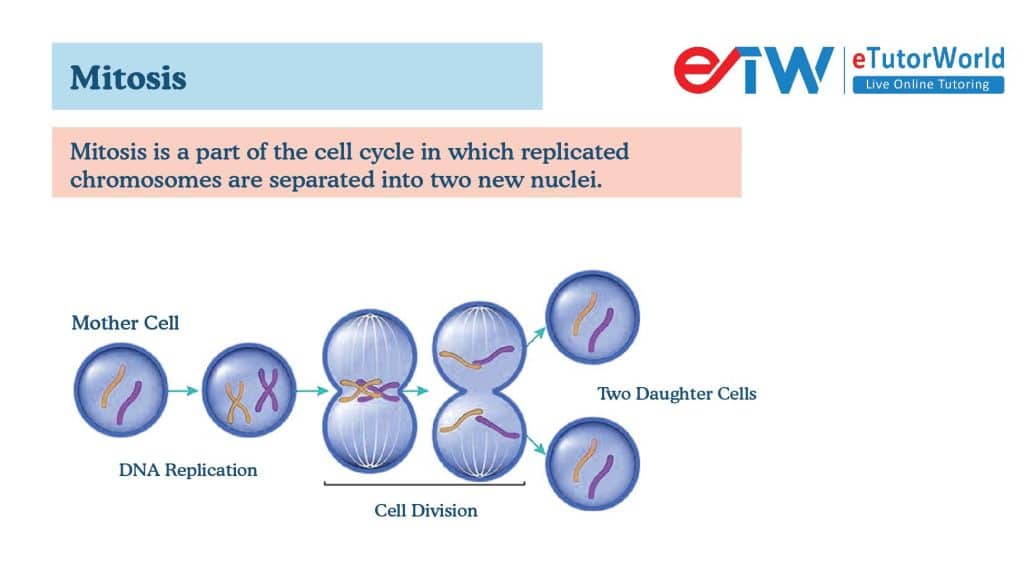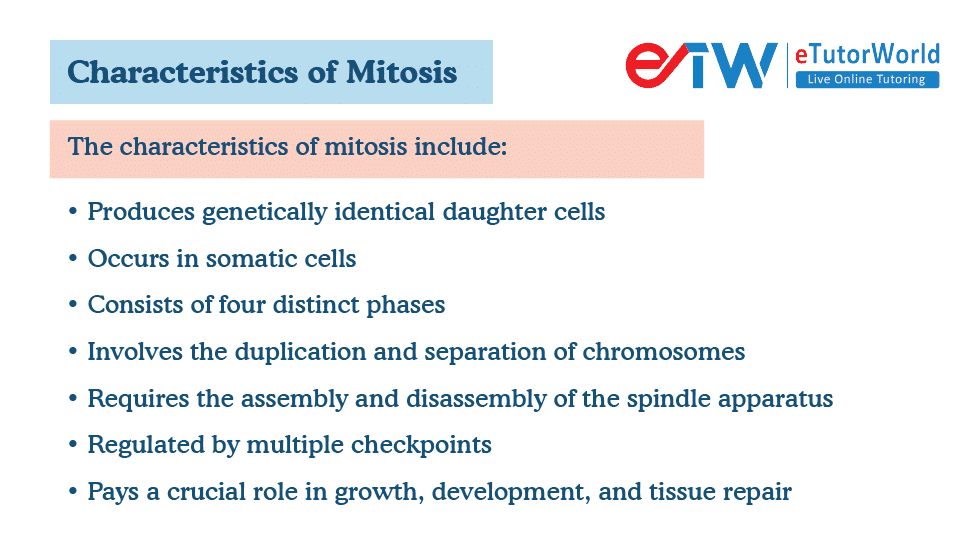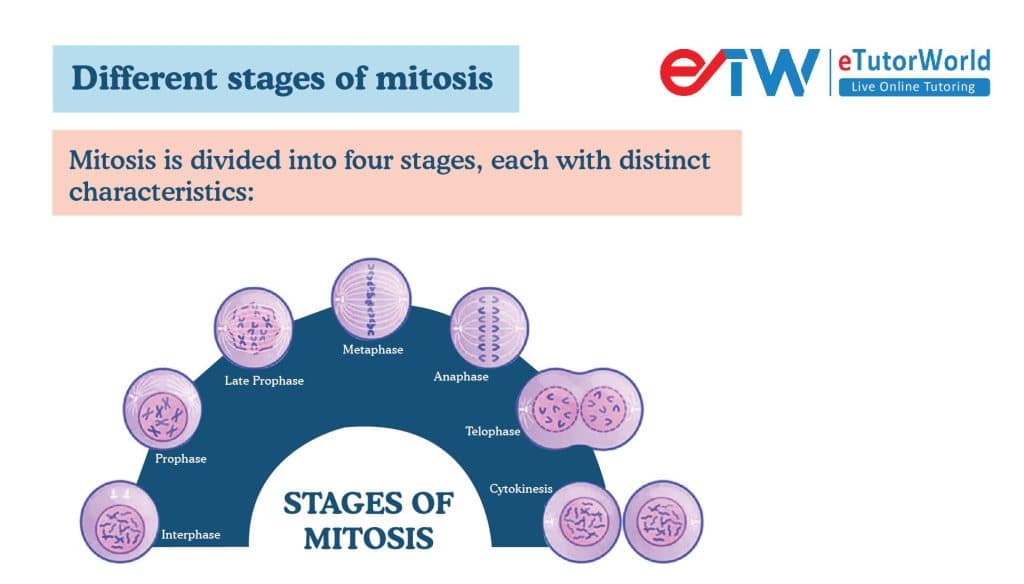Mitosis and Meiosis
Grade 6 Science Worksheets
Mitosis is a type of cell division that occurs in eukaryotic cells to produce two genetically identical daughter cells from a single-parent cell
Table of Contents:
- What are Longitudinal Waves?
- Formulae for Longitudinal Waves
- Characteristics of Longitudinal Waves
- Applications of Longitudinal Waves
- FAQs
Mitosis and Meiosis - Grade 6 Science Worksheet PDF
This is a free printable / downloadable PDF worksheet with practice problems and answers. You can also work on it online.
|
Untimed | |
Sign up with your email ID to access this free worksheet.
"We really love eTutorWorld!"
"We really love etutorworld!. Anand S and Pooja are excellent math teachers and are quick to respond with requests to tutor on any math topic!" - Kieran Y (via TrustSpot.io)
"My daughter gets distracted easily"
"My daughter gets distracted very easily and Ms. Medini and other teachers were patient with her and redirected her back to the courses.
With the help of Etutorworld, my daughter has been now selected in the Gifted and Talented Program for the school district"
- Nivea Sharma (via TrustSpot.io)
Mitosis
Mitosis is a type of cell division that occurs in eukaryotic cells to produce two genetically identical daughter cells from a single parent cell. It is a crucial process for the growth, development, and repair of tissues in multicellular organisms, as well as for asexual reproduction in some unicellular organisms.

The process of mitosis is typically divided into four main stages: prophase, metaphase, anaphase, and telophase. During prophase, the chromatin in the parent cell condenses to form visible chromosomes, and the nuclear envelope breaks down. The spindle apparatus, consisting of microtubules and associated proteins, also begins to form.
During metaphase, the chromosomes line up at the equator of the cell, or the metaphase plate, and are attached to the spindle apparatus via specialized structures called kinetochores. This ensures that each daughter cell receives an identical set of chromosomes.
During anaphase, the sister chromatids of each chromosome separate and are pulled towards opposite poles of the cell by the spindle fibers. This ensures that each daughter cell receives a complete set of chromosomes.
Finally, during telophase, the chromosomes arrive at the opposite poles of the cell, and the nuclear envelope reforms around each set of chromosomes. The cell then undergoes cytokinesis, or the physical separation of the two daughter cells, which completes the process of mitosis.
Overall, mitosis is a highly regulated and tightly controlled process that ensures the faithful transmission of genetic information from parent cells to daughter cells. Any errors in this process can lead to chromosomal abnormalities and potentially serious health problems.
Characteristics of Mitosis
The characteristics of mitosis include:

Produces genetically identical daughter cells: Mitosis is a process of cell division that results in the production of two daughter cells that are genetically identical to the parent cell.
Occurs in somatic cells: Mitosis occurs in somatic cells, which are all the cells in the body except for the reproductive cells.
Consists of four distinct phases: Mitosis is divided into four distinct phases, which are prophase, metaphase, anaphase, and telophase.
Involves the duplication and separation of chromosomes: During mitosis, the chromosomes in the parent cell are duplicated and separated into two identical sets, which are then distributed into the two daughter cells.
Requires the assembly and disassembly of the spindle apparatus: The spindle apparatus, which is made up of microtubules and associated proteins, is responsible for separating the chromosomes during mitosis.
Regulated by multiple checkpoints: Mitosis is regulated by multiple checkpoints throughout the process to ensure that the daughter cells receive a complete and accurate set of chromosomes.
Plays a crucial role in growth, development, and tissue repair: Mitosis is essential for the growth and development of multicellular organisms, as well as for the repair and maintenance of tissues.
Overall, mitosis is a highly regulated and tightly controlled process that ensures the faithful transmission of genetic information from parent cells to daughter cells. Any errors in this process can lead to chromosomal abnormalities and potentially serious health problems.
Different Stages of Mitosis
Mitosis is divided into four stages, each with distinct characteristics:
Prophase: In prophase, the chromatin in the nucleus of the parent cell condenses to form visible chromosomes, and the nuclear envelope breaks down.
The spindle apparatus, consisting of microtubules and associated proteins, also begins to form.

Metaphase: In metaphase, the chromosomes line up at the equator of the cell, or the metaphase plate, and are attached to the spindle apparatus via specialized structures called kinetochores. This ensures that each daughter cell receives an identical set of chromosomes.
Anaphase: In anaphase, the sister chromatids of each chromosome separate and are pulled towards opposite poles of the cell by the spindle fibers. This ensures that each daughter cell receives a complete set of chromosomes.
Telophase: In telophase, the chromosomes arrive at the opposite poles of the cell, and the nuclear envelope reforms around each set of chromosomes. The cell then undergoes cytokinesis, or the physical separation of the two daughter cells, which completes the process of mitosis.
Each stage of mitosis is critical for the proper division of genetic material, and each stage is tightly regulated by checkpoint mechanisms to ensure that the process is error-free.
Evolutionary Benefits of Mitosis
Mitosis is the process by which eukaryotic cells divide into two identical daughter cells. There are several evolutionary benefits of mitosis, including:
Increased reproduction: Mitosis allows cells to reproduce quickly and efficiently, enabling organisms to grow and reproduce rapidly.
Genetic stability: Mitosis ensures that the genetic material in each daughter cell is identical to the parent cell. This helps maintain genetic stability within a population.
Repair and regeneration: Mitosis plays a crucial role in the repair and regeneration of damaged tissues. It allows damaged cells to be replaced by new, healthy cells.
Adaptation to changing environments: Mitosis allows organisms to adapt to changing environments by producing cells that are specialized for specific functions.
Maintenance of chromosome number: Mitosis helps to maintain the correct chromosome number in each daughter cell, preventing the accumulation of mutations and chromosomal abnormalities over time.
Overall, mitosis is an important evolutionary mechanism that has contributed to the success and diversity of life on Earth.
Meiosis
Meiosis is a type of cell division that produces haploid cells, which are cells with half the number of chromosomes as the parent cell. Meiosis occurs in sexually reproducing organisms and is important for the production of gametes, such as sperm and eggs.
During meiosis, the DNA in the parent cell is replicated, and the cell undergoes two rounds of division, resulting in four haploid daughter cells. Meiosis has two phases: meiosis I and meiosis II.
In meiosis I, the homologous chromosomes pair up and exchange genetic material through a process called crossing over. This results in genetic diversity in the daughter cells. The homologous chromosomes then separate and move to opposite poles of the cell.
In meiosis II, the sister chromatids separate and move to opposite poles of the cell, resulting in four haploid daughter cells with unique genetic combinations. Meiosis is a complex process that is critical for sexual reproduction and genetic diversity in populations.
Characteristics of Meiosis
Reduction in chromosome number: The main function of meiosis is to produce haploid cells, which have half the number of chromosomes as the parent cell. This is achieved through two rounds of division, resulting in four daughter cells that are genetically different from each other and from the parent cell.
Crossing over: During meiosis I, homologous chromosomes pair up and exchange genetic material through a process called crossing over. This results in genetic recombination and increases genetic diversity in the daughter cells.
Independent assortment: During meiosis I, the homologous chromosomes separate randomly, leading to an independent assortment of the genes on those chromosomes. This further increases genetic diversity in the daughter cells.
Synapsis: Synapsis is the pairing of homologous chromosomes during meiosis I. This allows for crossing over and genetic recombination to occur.
Two stages: Meiosis consists of two stages: meiosis I and meiosis II. Meiosis I involves the separation of homologous chromosomes, while meiosis II involves the separation of sister chromatids.
Importance in sexual reproduction: Meiosis is essential for sexual reproduction in eukaryotic organisms. It allows for the production of haploid gametes, such as sperm and eggs, which combine during fertilization to form a diploid zygote.
Overall, meiosis is a complex process that is critical for sexual reproduction and genetic diversity in populations. The characteristics of meiosis, including a reduction in chromosome number, crossing over, independent assortment, synapsis, and two stages, all contribute to the genetic diversity of offspring and the evolution of populations over time.
Different Stages of Meiosis
Meiosis consists of two main stages: meiosis I and meiosis II. Each stage has several steps or phases, which are as follows:
Meiosis I:
Prophase I: The chromosomes condense, and homologous chromosomes pair up to form a tetrad. Crossing over, the exchange of genetic material between homologous chromosomes occurs during this stage.
Metaphase I: The tetrads line up at the center of the cell, with the spindle fibers attached to each chromosome.
Anaphase I: The homologous chromosomes separate and move to opposite poles of the cell, pulled by the spindle fibers.
Telophase I: The chromosomes reach the poles of the cell, and the cell undergoes cytokinesis, splitting into two daughter cells.
Meiosis II:
Prophase II: The chromosomes condense again, and the nuclear membrane breaks down.
Metaphase II: The chromosomes line up at the center of the cell, with the spindle fibers attached to each chromatid.
Anaphase II: The sister chromatids separate and move to opposite poles of the cell, pulled by the spindle fibers.
Telophase II: The chromosomes reach the poles of the cell, and the cell undergoes cytokinesis, splitting into four haploid daughter cells.
Overall, meiosis is a complex process that results in the production of haploid daughter cells with unique genetic combinations.
The stages of meiosis are carefully controlled to ensure that the correct number of chromosomes is distributed to each daughter cell and that genetic diversity is maximized through processes such as crossing over and independent assortment.
Evolutionary Benefits of Meiosis
Meiosis has several evolutionary benefits, including:
Genetic diversity: Meiosis generates genetic diversity by shuffling and recombining genetic material between homologous chromosomes during crossing over in meiosis I and independent assortment in meiosis II. This increases the potential for adaptation to changing environmental conditions and the likelihood of the survival of a species in a changing world.
Elimination of harmful mutations: During meiosis, damaged or harmful mutations can be eliminated from the population as they are either not passed on to the offspring or are diluted by recombination with other genetic material.
Production of haploid gametes: Meiosis produces haploid gametes, which are necessary for sexual reproduction. This allows for the fusion of gametes from two different individuals, resulting in the production of genetically diverse offspring.
Evolution of new species: Meiosis can lead to the production of new combinations of genes, which can lead to the evolution of new species. This is especially important in the case of speciation through polyploidy, where a species can gain an entire set of chromosomes through meiotic error, leading to the formation of a new species.
Overall, the evolutionary benefits of meiosis include the generation of genetic diversity, elimination of harmful mutations, production of haploid gametes, and evolution of new species. These benefits have been critical in the evolution and diversification of life on Earth.
“There have been times when we booked them last minute, but the teachers have been extremely well-prepared and the help desk at etutorworld is very prompt.
Our kid is doing much better with a higher score.”
6th Grade Tutoring
eTutorWorld offers Personalized Online Tutoring for Math, Science, English, and Standardised Tests.
Our Tutoring Packs start at just under $22.49 per hour, and come with a moneyback guarantee.
Schedule a FREE Trial Session, and experience quality tutoring for yourself. (No credit card required.)
Difference Between Mitosis and Meiosis
Mitosis and meiosis are two types of cell division that are responsible for producing new cells. While both processes involve the division of a cell’s nucleus, there are several key differences between mitosis and meiosis, including:
Purpose: Mitosis is a type of cell division that is responsible for the growth and repair of somatic cells (non-sex cells), while meiosis is a specialized type of cell division that is responsible for producing gametes (sex cells).
Chromosome number: In mitosis, the number of chromosomes in the parent cell is preserved in the daughter cells, whereas in meiosis, the number of chromosomes in the parent cell is halved, resulting in four daughter cells that each contain half the number of chromosomes as the parent cell.
Genetic variation: Mitosis produces genetically identical daughter cells, whereas meiosis generates genetic variation through the process of crossing over and independent assortment of chromosomes.
Number of divisions: Mitosis involves a single division of the nucleus, while meiosis involves two divisions of the nucleus.
Daughter cell production: Mitosis produces two identical daughter cells, while meiosis produces four genetically diverse daughter cells.
Overall, mitosis is responsible for growth and repair of somatic cells, while meiosis is responsible for producing genetically diverse gametes.
Do You Stack Up Against the Best?
If you have 30 minutes, try our free diagnostics test and assess your skills.
FAQS
What is mitosis?
Mitosis is a type of cell division that results in the formation of two identical daughter cells, each with the same number of chromosomes as the parent cell. It is responsible for growth and repair of somatic cells in the body.
What is meiosis?
Meiosis is a type of cell division that results in the formation of four genetically diverse daughter cells, each with half the number of chromosomes as the parent cell. It is responsible for producing gametes (sex cells) in sexually reproducing organisms.
What is the purpose of mitosis?
The purpose of mitosis is to produce new cells for growth and repair of somatic tissues in the body.
What is the purpose of meiosis?
The purpose of meiosis is to produce gametes (sperm and egg cells) for sexual reproduction.
Which types of cells undergo mitosis?
Somatic cells in the body undergo mitosis.
Which types of cells undergo meiosis?
Gametes (sex cells) in sexually reproducing organisms undergo meiosis.

Kathleen Currence is one of the founders of eTutorWorld. Previously a middle school principal in Kansas City School District, she has an MA in Education from the University of Dayton, Ohio. She is a prolific writer, and likes to explain Science topics in student-friendly language. LinkedIn Profile
Affordable Tutoring Now Starts at Just $22.49
eTutorWorld offers affordable one-on-one live tutoring over the web for Grades K-12. We are also a leading provider of Test Prep help for Standardized Tests (SCAT, CogAT, MAP, SSAT, SAT, ACT, ISEE, and AP).
What makes eTutorWorld stand apart are: flexibility in lesson scheduling, quality of hand-picked tutors, assignment of tutors based on academic counseling and diagnostic tests of each student, and our 100% money-back guarantee.
Whether you have never tried personalized online tutoring before or are looking for better tutors and flexibility at an affordable price point, schedule a FREE TRIAL Session with us today.
*There is no purchase obligation or credit card requirement
Grade 6 Science Worksheets
- Inquiry process
- Nature of Science
- Scientific Inquiry
- Inquiry, Analysis and Problem Solving
- Ethical Practices
- Science and Society
- Biotic and Abiotic Factors
- Impact of Organisms
- Adaptation
- Spheres of Earth
- Natural Resources
- Environmental Issues
- Conservation of Earth
- Understanding Technology
- Abilities To Do Technological Design
- Structure of Earth
- Solar System
- Rocks and Fossils
- Earth Systems
- Plate Tectonics
- Evolution
- Magnetic Field of Earth
- Geologic Time
- Materials and Processes That Shape a Planet
- Astronomy
- Ecology
- Energy
- Kinetic and Potential Energy
- Energy Transfer
- Matter and its Structure
- States of Matter
- Physical and Chemical Changes
- Force and Motion
- Electricity and Magnetism
- Wave Interactions
- Sound
- Light
- Introduction to Life Science
- The Origin & History of Life On Earth
- Plant and Animal Cells
- Parts of a Cell
- The Cell Cycle
- How Living Organisms Get Energy
- Classification of Organisms
- How Plants Grow & Reproduce
- The Human Respiratory System
- The Human Cardiovascular System
- The Human Digestive System
- The Human Endocrine Systems
- The Human Nervous System
- The Human Muscular System
- The Human Skeletal System
IN THE NEWS

Our mission is to provide high quality online tutoring services, using state of the art Internet technology, to school students worldwide.
Online test prep and practice
SCAT
CogAT
SSAT
ISEE
PSAT
SAT
ACT
AP Exam
Science Tutoring
Physics Tutoring
Chemistry Tutoring
Biology Tutoring
Math Tutoring
Pre-Algebra Tutoring
Algebra Tutoring
Pre Calculus Tutoring
Calculus Tutoring
Geometry Tutoring
Trigonometry Tutoring
Statistics Tutoring
Quick links
Free Worksheets
Fact sheet
Sales Partner Opportunities
Parents
Passive Fundraising
Virtual Fundraising
Our Expert Tutors
Safe and Secure Tutoring
Interactive Online Tutoring
After School Tutoring
Elementary School Tutoring
Middle School Tutoring
High School Tutoring
Home Work Help
Math Tutors New York City
Press
©2022 eTutorWorld Terms of use Privacy Policy Site by Little Red Bird
©2022 eTutorWorld
Terms of use
Privacy Policy
Site by Little Red Bird










